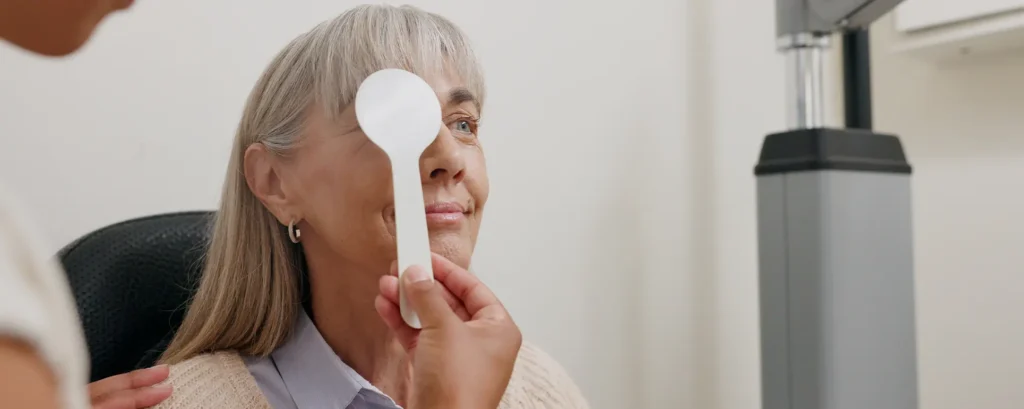When most people think about cataract surgery, they assume that the new lens implanted during the procedure is a “done deal”. Once it’s in place, that’s the vision you’ll have going forward. But what if there was a way to actually adjust your vision after surgery — almost like fine-tuning the lens inside your eye? That’s exactly what RxSight’s Light Adjustable Lens (LAL) allows.
This lens is unlike anything else currently available. Instead of locking in your prescription on the day of surgery, it gives both you and your surgeon the chance to test different visual outcomes in real life. After surgery, once your eye has healed, your surgeon can use targeted UV light treatments to reshape the lens inside your eye and adjust your vision. Once you’re happy with the results, the final setting is permanently “locked in”.
In this article, we’ll go step by step through how the LAL works, what makes it different from other intraocular lenses (IOLs), who it’s best suited for, and the kinds of results you can realistically expect. By the end, you’ll have a clear sense of whether this technology is right for you — and the questions you should ask if you’re considering it.
What Makes the RxSight Light Adjustable Lens Different?

The standout feature of the Light Adjustable Lens is in its name — it’s adjustable. Unlike traditional monofocal or multifocal lenses, which are set to a fixed prescription, the LAL can be modified after implantation.
This is a significant leap forward because even with the most advanced pre-surgery measurements, there is always a margin of error. The eye can heal slightly differently than expected, or corneal shape can influence the final result. With a standard lens, you’d either live with that difference or rely on glasses or further surgery. With the LAL, your surgeon can make changes after seeing how your eye actually settled.
Think of it as getting a tailored suit rather than one off the rack. The measurements before surgery give an excellent starting point, but the adjustments afterwards are what really ensure the perfect fit.
How Does the Light Adjustable Lens Work?
The lens is made of a special photosensitive material that reacts to ultraviolet (UV) light. After cataract surgery, once your eye has healed enough, your surgeon uses a device that emits a controlled UV beam onto the implanted lens. This light reshapes the polymer structure of the lens, changing its focusing power.
The process is completely painless. Each adjustment session usually takes just a few minutes, and patients typically need between 2–4 treatments to reach their optimal prescription. After the final adjustment, a “lock-in” treatment is done to prevent any further changes.
During the adjustment period, you’ll need to wear special UV-blocking glasses whenever you’re awake, both indoors and outdoors. This prevents any accidental exposure to UV light from sunlight or artificial sources from altering the lens unintentionally. Once your lens is locked in, you can stop wearing the glasses.
Benefits of the Light Adjustable Lens
Personalised Vision Outcomes
Perhaps the biggest benefit is that you aren’t locked into one prescription straight away. If you want sharper distance vision, more focus for near work, or a balanced compromise, you can test it in real life and then decide.
Higher Patient Satisfaction
Clinical studies consistently show that patients with LALs are more likely to achieve their desired outcome compared to those with fixed-power lenses. That’s because the lens is fine-tuned based on actual experience rather than prediction.
Reduced Dependence on Glasses
For many patients, the ability to trial and select the best prescription leads to a much lower need for glasses after surgery. While glasses can still be useful for certain tasks, most people enjoy greater freedom in daily life.
A Safety Net for Complex Eyes
For patients with previous refractive surgery (like LASIK or PRK), predicting the exact power of an IOL can be tricky. The LAL provides a safety net because adjustments can be made postoperatively to fine-tune vision that would otherwise be unpredictable.
Limitations and Things to Be Aware Of
While the LAL offers exciting advantages, it isn’t perfect. There are practical commitments you’ll need to consider:
The UV Glasses Requirement
For several weeks after surgery, until the final lock-in treatment is complete, you must wear UV-blocking glasses whenever you’re exposed to light. Some patients find this inconvenient, especially if they forget them.
More Follow-Up Visits
Compared to standard cataract surgery, the LAL involves more trips back to your surgeon for adjustment and lock-in sessions. This requires both time and commitment.
Cost Considerations
The LAL is generally more expensive than traditional monofocal or multifocal IOLs. You’ll need to weigh up whether the extra cost is worthwhile for the potential of customisable results.
Availability
Because the technology is relatively new, it may not be offered at every clinic or by every surgeon. You’ll need to seek out a centre that has the equipment and training.
Who Is a Good Candidate for the Light Adjustable Lens?

The LAL isn’t necessarily the best choice for every patient, but it shines in certain situations:
- Patients who want maximum precision – If you’re particularly concerned about reducing glasses dependence and want to fine-tune your outcome, this lens is designed for you.
- Patients with previous LASIK or PRK – These eyes are more challenging to calculate accurately, making the flexibility of adjustments a big advantage.
- Patients unsure about monovision – Some people aren’t sure whether they’d like one eye corrected for distance and the other for near. With the LAL, you can trial it and change if it doesn’t feel right.
- Those willing to commit to follow-up visits – Success depends on completing the adjustment and lock-in sessions as advised.
How Does the LAL Compare to Other Lens Options?
Versus Monofocal Lenses
Monofocal lenses give clear vision at one set distance (usually distance vision), but glasses are usually needed for near work. The LAL provides the same quality clarity but with the added bonus of adjustability afterwards.
Versus Multifocal and Trifocal Lenses
Multifocal and trifocal lenses split light to give both distance and near vision. They can reduce dependence on glasses but sometimes cause halos or glare at night. The LAL doesn’t split light — instead, it fine-tunes focus. Some patients find this gives them clearer, sharper vision with fewer visual side effects, though they may still need glasses for very fine near work.
Versus Extended Depth of Focus (EDOF) Lenses
EDOF lenses provide a continuous range of vision, especially helpful for intermediate tasks like computer use. The LAL doesn’t naturally extend depth of focus, but adjustments allow a personalised prescription that can achieve similar lifestyle outcomes without the optical trade-offs of EDOF lenses.
Safety and Long-Term Results
Safety data on the LAL has been very reassuring. The adjustment treatments are non-invasive and painless. The most important factor is strict adherence to the UV glasses rule during the adjustment period to prevent unintended lens changes.
Long-term studies show stable results after the final lock-in treatment, with no risk of the lens continuing to change over time. Patients report high satisfaction, with many saying it feels like they had multiple chances to “get it right” rather than relying on luck with a single fixed lens.
Step-by-Step: What to Expect if You Choose the LAL
- Initial Consultation – Measurements are taken, and your surgeon discusses your lifestyle needs and suitability.
- Surgery Day – Cataract surgery is performed as usual, with the LAL implanted in place of your cloudy lens.
- Healing Period – You’ll wear the UV-blocking glasses straight away and return for a check-up after a week or two.
- Adjustment Sessions – Once your eye has healed, you’ll have one or more adjustment sessions, where your surgeon uses the UV light device to reshape the lens.
- Testing Vision in Real Life – Between adjustments, you try out your vision in your everyday environment to see what works best.
- Final Lock-In Treatment – Once you’re happy, your surgeon locks in the prescription. After this, the lens is stable, and the glasses are no longer needed.
FAQs
1. How long does the Light Adjustable Lens process take?
The timeline from surgery to your final “locked-in” vision is typically between four and six weeks, though it can be longer depending on how your eye heals and how many adjustments you need. After the cataract operation, your eye usually needs one to two weeks to recover before adjustments begin. Each adjustment session is spaced a few days apart, and most patients need two to four sessions. Once the final prescription is chosen, a lock-in treatment is done, and the process is complete.
2. Are the UV light treatments painful?
The adjustment sessions are completely painless and don’t involve any surgical cutting or touching of the eye. You simply sit in front of a machine while a gentle, controlled beam of ultraviolet light is directed onto your implanted lens. The treatment usually takes less than five minutes, and most patients describe it as no different from sitting at an eye test. There is no downtime afterwards, and you can resume normal activities straight away.
3. Why do I need to wear special UV glasses?
The lens material is photosensitive, which means it responds to UV light. While it is in its adjustable phase, even normal exposure to sunlight or bright indoor light could alter the lens unintentionally. The UV-blocking glasses prevent this from happening by shielding the lens from stray rays. You’ll need to wear them all day, indoors and outdoors, until the lock-in is complete. Although it may seem inconvenient, it’s a temporary measure that ensures your adjustments are precise and controlled.
4. Can the lens be changed again years later if my vision alters?
No, the adjustments can only be made during the initial treatment period before the lock-in stage. Once the prescription is fixed, the lens remains stable and will not alter over the years. If your vision changes later — for example, due to natural changes in the eye or another condition — these would usually be managed with glasses, contact lenses, or in some cases laser enhancement. The LAL isn’t designed to be a lifetime “re-adjustable” lens, but rather to give the most accurate outcome at the time of surgery.
5. Is the Light Adjustable Lens available on the NHS?
Currently, the LAL is only available privately in the UK, as the NHS does not yet fund this technology. That means you’ll need to attend a private cataract clinic with the equipment and trained surgeons who offer it. Because it is relatively new and requires investment in specialist machines, not all clinics provide it. If you’re interested, it’s worth asking your chosen cataract centre whether they have access to the RxSight system.
6. How does it perform for night driving?
One of the strengths of the LAL is that it does not split incoming light like multifocal or trifocal lenses, which can sometimes cause glare or halos around lights at night. Many patients report that their night vision feels more natural and crisp compared to multifocal options, making the LAL a good choice for those who drive regularly after dark. That said, your final outcome will depend on the adjustments chosen and whether you opt for monovision, blended vision, or a focus purely on distance.
7. How much more does it cost than standard lenses?
The Light Adjustable Lens usually costs more than standard monofocal or even premium multifocal lenses, reflecting both the advanced technology and the extra aftercare involved. You’re not just paying for the lens itself, but also for the multiple adjustment sessions and the UV lock-in process. Prices vary between clinics, but you can expect it to be one of the more expensive options available. Many patients feel the additional cost is justified because it reduces the chance of being left with an imperfect prescription after surgery.
8. Who is not a good candidate for the LAL?
This lens may not be suitable for patients who cannot attend several follow-up appointments or who are unlikely to wear the UV-blocking glasses consistently. It is also less commonly recommended for people with advanced eye diseases such as macular degeneration or severe glaucoma, where vision may still be limited regardless of lens precision. Your surgeon will assess your eyes carefully to check if the LAL would give you meaningful benefits before suggesting it.
9. How many adjustment sessions are normally needed?
Most patients require between two and four adjustment sessions to reach their optimal vision. Each one makes a small change, and you can then “test drive” your new prescription in daily life before deciding if more fine-tuning is required. Once you and your surgeon are satisfied, a final lock-in treatment secures the prescription permanently. Having several opportunities to adjust is what makes this lens unique, as it lets you settle on the vision that feels most comfortable and practical for you.
10. Will I definitely be glasses-free afterwards?
While many patients reduce their dependence on glasses dramatically, complete glasses independence cannot be guaranteed. Some people still prefer reading glasses for very fine print or long sessions of close work, depending on the prescription chosen. The key advantage is that you can test how different settings feel and pick the one that suits your lifestyle best. For example, you may choose to prioritise distance vision for driving or reading vision for close-up work, and the LAL allows you to make that decision with real-life experience.
Final Thoughts
The RxSight Light Adjustable Lens is one of the most exciting developments in cataract surgery in recent years. For patients who want maximum precision and the ability to trial their vision before locking it in, it offers a level of customisation no other lens currently matches.
That said, it does come with responsibilities: wearing the UV glasses, attending multiple follow-up visits, and covering the additional cost. If you’re happy with these commitments, the payoff is the chance to fine-tune your eyesight to suit your lifestyle perfectly.
If you’re considering cataract surgery and want to explore advanced options such as the RxSight Light Adjustable Lens, our team at London Cataract Centre can guide you through your choices. With access to the latest technology and highly experienced surgeons, you can feel confident that your vision is in safe hands.
References
- Folden, D.V., Wong, J.R., Lopez, M., Schallhorn, J.M. & Hovanesian, J.A. (2022) ‘Visual outcomes of an enhanced UV-protected light adjustable lens using a novel co-managed, open-access methodology’, Clinical Ophthalmology, 16, pp. 2413–2420. Available at: https://pmc.ncbi.nlm.nih.gov/articles/PMC9359783/ (Accessed 15 October 2025).
- Wong, J.R., Folden, D.V., Lopez, M. & Hovanesian, J.A. (2023) ‘Visual outcomes of a second-generation, enhanced UV-protected Light Adjustable Lens in eyes with prior corneal refractive surgery’, Clinical Ophthalmology, 17, pp. 3709–3718. Available at: https://pmc.ncbi.nlm.nih.gov/articles/PMC10637228/ (Accessed 15 October 2025).
- Jones, M., Brinton, J.P., Hovanesian, J.A. & Moshirfar, M. (2024) ‘Clinical outcomes of the light-adjustable lens in eyes with a history of laser corneal refractive surgery’, Journal of Cataract & Refractive Surgery. Available at: https://pubmed.ncbi.nlm.nih.gov/38736178/ (Accessed 15 October 2025).
- U.S. Food and Drug Administration (2017) Light Adjustable Lens (LAL) and Light Delivery Device (LDD) – Summary of Safety and Effectiveness Data (P160055). Silver Spring, MD: FDA. Available at: https://www.accessdata.fda.gov/cdrh_docs/pdf16/P160055D.pdf (Accessed 15 October 2025).
- Abdelghany, A.A. & Alio, J.L. (2014) ‘Surgical options for correction of refractive error following cataract surgery’, Eye and Vision, 1, 2. Available at: https://pmc.ncbi.nlm.nih.gov/articles/PMC4604120/ (Accessed 15 October 2025).

